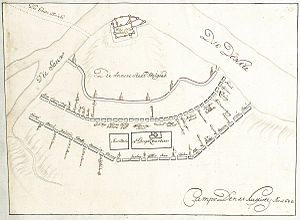Siege of Belgrade (1688)
| date | August 7 to September 6, 1688 |
|---|---|
| place | Belgrade , Serbia |
| output | Conquest of Belgrade |
| Parties to the conflict | |
|---|---|
| Commander | |
| Troop strength | |
| 34,000 men | 13,000 men |
| losses | |
|
700 |
7000 |
The siege of Belgrade in 1688 was part of the Great Turkish War . Troops of the Holy Roman Empire , especially imperial Austrian ones , fought against the Ottomans . The siege ended with a victory for the attacking imperial troops.
prehistory
The success of the imperial troops in 1687 had several consequences. Generals Johann Heinrich von Dünewald and Karl von Lothringen were able to advance into Transylvania and Slavonia . The Ottomans, who were still weakened by the battle of Mohács , were able to offer little resistance. Against this background, the Hungarian Diet agreed to transfer the hereditary royal dignity to the House of Habsburg . The defeat led to the overthrow of the Grand Vizier Suleiman Pasha in the Ottoman Empire and later also of the Sultan Mehmed IV himself.
Now the imperial army command intended to conquer the city of Belgrade in 1688 . At that time, this represented the strongest Ottoman position of power in the Hungarian region.
A main army of around 40,000 men was to march directly from the north towards Belgrade. A smaller force under Ludwig von Baden was supposed to march on the right bank of the Danube towards Belgrade.
The supreme command in the imperial camp was in dispute . This went so far that the Bavarian Elector Max Emanuel questioned his participation and that of the Bavarian troops , should he not be entrusted with the high command. It was only when Charles of Lorraine became ill that Max Emanuel actually received command.
course
The army found by Max Emanuel was actually only about 34,000 men strong. It was the weakest since the beginning of the war. Without waiting for the advance of the troops under Ludwig von Baden, the elector let his troops march. To cross the Sava , the army carried 60 to 70 dismantled ships with them. On the night of August 7th to 8th, 1688, the river was crossed despite an Ottoman counterattack. The Ottoman commander Jegen Pascha withdrew with his main force of 13,000 men. In the fortress of Belgrade he left 4,000–5,000 men under Ibarahim Pasha von Szegzard. Most of the city's residents had crossed the Danube to safety.
After the city was enclosed, the siege systems began to be put in place. The trenches were opened on August 25th. The Belgrade Fortress was bombarded for days with 40 cannons of the largest caliber and 15 mortars. On September 6th the imperial troops attacked from three sides simultaneously. The first wall was quickly taken, behind which the attackers encountered a second fortification built later. After the conquest, there was a bloodbath that killed numerous Ottoman defenders . A total of 7,000 Ottomans were killed. The Turkish commander was taken prisoner. The attackers had lost 700 men. However, there were several generals among them. Other troop leaders, including the Commander-in-Chief Max Emanuel von Bayern and Major Henning von Stralenheim , had been wounded.
After the victory the campaign of 1688 essentially ended. In 1690 the Ottomans recaptured the city.
literature
- Hans Eggert von der Lühe (Ed ..): Military Konversationslexikon, Vol. 1 . Wigand Verlag, Leipzig 1833, p. 485
- Marcus Junkelmann : Elector Max Emanuel of Bavaria as general. Utz Verlag, Munich 2000, ISBN 3-89675-731-8 , pp. 62-64 (also dissertation, University of Munich 1979).
- Hans-Joachim Böttcher : The Turkish Wars in the Mirror of Saxon Biographies . Gabriele Schäfer Verlag Herne 2019, ISBN 978-3-944487-63-2 . Pp. 145-157.
